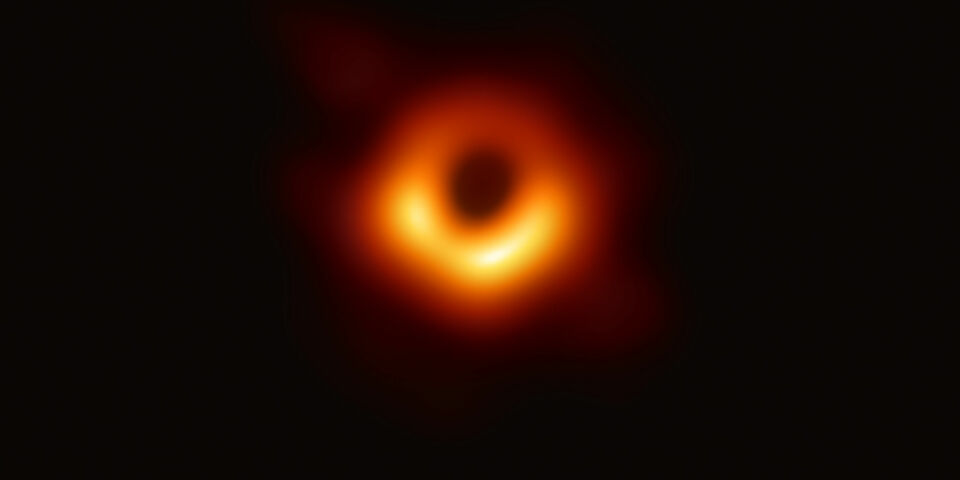The story behind the black hole
It took nearly three hundred and fifty scientists, divided over more than sixty institutions in twenty countries, approximately ten years to get it done: the first ‘photo’ of a black hole, which was presented to the world on April 10th of this year. Monika Moscibrodzka, assistant professor at Radboud University Nijmegen, was one of those scientists. Crowds of people with an interest flocked to the Blauwe Zaal Wednesday afternoon to hear her give a firsthand account of how that historic image came about.
The first proof that Einstein’s General Theory of Relativity predicted what we now refer to as a ‘black hole’ was provided in the trenches of the First World War, Moscibrodzka told her audience with much feeling for the kind of details that can make an academic discourse more engaging. Because it was the German Karl Schwartzschild who, while serving on the Russian eastern front in 1915, came up with a solution to Einstein’s recently formulated field equations, starting from a non-rotating point mass. Once this mass becomes heavy enough, even light can’t escape its gravitational force. Everything within the so-called Schwartzschild radius gets sucked irrevocably into the ‘black hole,’ as this phenomenon is known since the early 1960s.
Despite the fact that since that time, the likely existence of black holes has been inferred by their gravitational force on objects surrounding them - it is suspected that supermassive black holes keep galaxies together -, the announcement of the first ever ‘photo’ of a black hole, dubbed M87, in spring of this year was celebrated as the first direct evidence of the existence of these fascinating objects. It should be noted, Moscibrodzka openly admitted, that the image is in fact not a normal photo at all: what we see is a ‘false-color’ image of millimeter waves that are undetectable by the human eye - basically a kind of radio signal.
Event Horizon Telescope
That image is the result of an immense coordinated effort known as the Event Horizon Telescope project, wherein a large telescope array consisting of eight radio telescopes in Arizona, Chile, Mexico, Hawaii, Spain and the South Pole were combined to form one huge interferometer. This resulted in a kind of virtual telescope with roughly the same diameter as Earth. This was necessary, the astrophysicist from Nijmegen explained, because the apparent size of that black hole at a distance of more than fifty million light years away is comparable to that of an apple on the moon. “And the larger the diameter of a telescope, the better the resolution.”
One requirement of this method, however, was that the weather conditions had to be perfect in each of these locations at the same time, with a clear ‘view’ of the black hole in the Virgo constellation. This was the case for four days during one week in 2017, and in that time, a total of four million gigabytes of raw data was collected. “That amounts to a film in high definition each second,” Moscibrodzka clarified. In order to process all that data - and moreover to compare the signals of these various telescopes - it had to be transported “in a small briefcase on a plane” to a central location.
Gaps in the data
And the scientists still had anything but a complete picture, the speaker explained. “There were quite a number of gaps in the data that needed to be filled, and for that we had to make assumptions.” In order to reduce the influence of human preconceptions, the scientists were dived into four teams with no contact between them whatsoever. They all produced an image based on their own software and assumptions, which, much to Moscibrodzka’s relief, turned out to be surprisingly similar. Even though the data processing took six months, she says that at this point, it won’t take a smart student much longer than three minutes to reproduce that now iconic image on his laptop. “We put the data and the software online, so go ahead and try it yourself!”
The big waiting has now started for an image of the supermassive black hole at the center of our own galaxy, the Milky Way. The researcher from Nijmegen divulged that this will be film footage. “Our black hole is a thousand times less massive than M87, which makes it quite variable - it’s better to capture that in moving images.”


Discussion